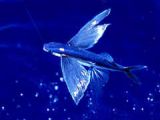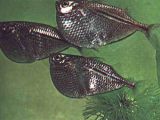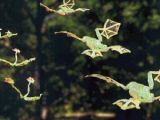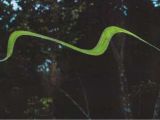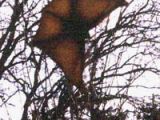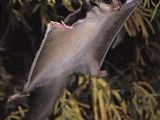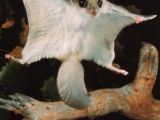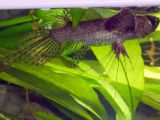There are three groups of living animals that we associate with the flight: birds, bats and insects.
But there are also other groups of animals that can manage to take off and "defeat" gravitation on shorter or longer bursts. They are generally called gliders.
Here are classical examples.
1. There are over 52 species of the so-called flying fishes, grouped in 8 genera and one family (Exocoetidae).
Fish use "flight" to escape water predators. The most famous are the mostly tropical oceanic flyingfishes (52 species in 8 genera), which grow no longer than 40 cm (1.3 ft), the best known species being Exocoetus volitans.
Before the "flight", the fish swim at the surface of the water with an incredible speed: 18 m (60 ft) per second. The initial speed of the flight is given by a tail splash in the water (that's why the caudal fin is deeply forked; the upper lobe shorter than the lower), and the fish execute the flight with their enormous pectoral fins.
This way, they can fly 30-100 m (100-330 ft) and in exceptional cases, when helped by the wind, even 400 m (1,350 ft), at a height of 5-6 m (16-20 ft) over the water. Successive jumps normally sum at least 500 m (1,660 ft). The flight's speed can be of 7-20 m (23-66 ft) per second, and in short bursts with 108 km (70 mi) per hour.
Some flingfish species have also unusually large pelvic fins, giving them a four-winged appearance.
Some species of the Hemirhamphidae family (related to the flyingfishes) are prone to leap and skitter at the surface and one species, Euleptorhamphus velox can leap out of the water and glide like a flying fish, covering 50 m in two separate hops.
2. In the rivers of South America the freshwater hatchetfishes can be found, 3 species in 9 genera.
These minute fishes, no longer than 8 cm (3 inch)) and often found in aquariums, can jump for insects out of the water and even glide 3-4 m (10-13 ft). For the relatively long or high jumps, these fishes use their modified, elongated pectoral fin rays and heavily-muscled, enlarged pectoral girdle. Unlike flingfishes, hatchetfishes can assist their flight by rapidly striking their pectoral fins to evade predators, albeit only for distances of a few meters and in a straight line.
3. The freshwater butterflyfish (Pantodon bucholzi) lives in the rivers of tropical Africa and is no longer than 12 cm (4.5 inch). If enough speed is built up in the water, they are capable of jumping out of the water, to search for insects or to escape from predators.
It is not a glider, but a ballistic jumper, with a tremendous jumping power. It also wiggles its pectoral fins as it "flies", with the help of specialized, enlarged pectoral muscles, hence its common name.
4. The flying frogs are arboreal frogs with extensive webbing between their hands and feet, lateral skin flaps on the arms and legs, and reduced weight per snout-vent length. These morphological adaptations allow the flying frogs to glide through the air for 12-15 m (40-50 ft) at an angle of less than 45? relative to the horizontal, increasing their surface by stretching at maximum the webbing between their toes.
The most agile flying frogs are those from the genus Rhacophorus (closer to true frogs) found in southern India and southeastern Asia, but also some species of tree frogs (Hylla) from tropical America have developed this ability.
Even inside each genus, the gliding ability varies between species.
5. Flying dragons (Draco species) are perhaps the most famous gliding animals, comprising 28 arboreal species found in Southeast Asia, no longer than 38 cm (1.3 ft). The 5-6 elongated ribs and their connecting membrane can be extended to make a wing, the hind limbs are flattened and wing-like in cross-section, and a small set of flaps on the neck functions as a horizontal stabilizer.
When resting, the "parachute" stays folded on the side of the body like a fan.
Before taking off, the lizard fills its air sacs located under the neck and abdomen skin, so that the body swells like a balloon and glides like a zeppelin, headed by the tail and neck flaps. This way, this agamid lizard can glide up to 100 m (330 ft), but usually no more than 30 m (100 ft).
6. There are also 6 species of flying gecko lizards (Ptychozoon). They live also in southeastern Asia. These arboreal lizards mimic tree bark with their color patterns. Their toes, limbs, sides and Tails present skin flaps as an adaptation for gliding. Their tail and body too are flattened, also as an adaptation to gliding.
When the gecko leaps into the air, the flaps are used to generate lift and allow the gecko to control its fall. The two geckos from the genus Cosymbotus, living in the same area, have similar adaptations.
In the tropical forests of Africa live the two species of Holaspis, related with the wall lizards. They have fringed toes and tail sides and can flatten their bodies for gliding.
7. As incredible as it may seem, there are even flying snakes!
The 5 species (Chrysopelea genus) are found also - you've guessed! - in southeastern Asia, in whose forests most gliding animals are found. These arboreal snakes reach a maximum of 1.5 m (5 ft) and are slightly venomous (the venom is strong for their preys, frogs and lizards, including flying ones).
These snakes can glide by stretching out their body sideways and opening their ribs so the belly is concave, and by making lateral slithering movements. They can remarkably glide up to 100 m (330 ft) and make 90 degree turns.
8. The mammal best adapted for gliding is perhaps not known by many: the colugo.
The two species live, of course, in southeastern Asia, and are somehow related to the primates.
They have a patagium (skin membrane like in the bat's wings) that is as large as geometrically possible and can glide as far as 70 m (235 ft) with minimal loss of height, and the maximum glides can be 130 m (433 ft) long.
The patagium extends from the shoulder blades to the fore-paw, from the tip of the rear-most finger to the tip of the toes, and from the hind legs to the tip of the tail; unlike in other known gliding mammals even the spaces between the fingers and toes are webbed to increase the total surface area, as in the wings of bats.
9. The other gliding mammals are represented by gliding marsupials and flying squirrels.
There are 14 genera and 43 species of flying squirrels, all nocturnal. They have a patagium that stretches from their wrist to their ankle. Flying squirrels glide spread-eagle and with their tail fluffed out like a parachute, and grip the landing tree with their claws when they land. Giant flying squirrels from southern Asia are the largest gliding mammals: they have a length of 1.2 m (4 ft).
Large flying squirrels can glide up to 450 m (1,500 ft), using the tail like a rudder. Smaller species glide about 50 m (166 ft) with a speed of 8 km (5 mi) per hour. Most flying squirrels live in southern and eastern Asia; 2 smaller species in North America, and one in the taiga from Finland to Siberia.
The scaly-tailed flying squirrels (Anomaluridae family) of the African forests are rodents not closely related to the real squirrels, but which have evolved similar patagia and glide.
In the forests of eastern Australia and New Guinea live the 10 species of marsupial gliders, varying between 0.9 to 1.5 m (3-5 ft) in length and belonging to 3 families. Some have patagia extending just to the elbow; others till the wrist. They can glide up to 90 m (300 ft). Greater glider (Petauroides) (cat sized) feeds on Eucalyptus flowers and leaves; wrist-winged gliders (40 cm or 1.3 ft long) eat insects and plant matters while feathertail glider (Acrobates) (14 cm or 0.5 ft) is insectivorous.
The gliding membranes are hardly noticeable until they jump. While jumping, the animal extends all four legs and stretches the loose but muscularly controlled folds of skin. Two species have a stiff-haired feather-like tail that helps them steer in the air.
10. There are spider species practicing ... ballooning!
What's even more amazing is that they fabric from silk their ... aircrafts!
Thousands of flying money spiders from the Linyphiidae family can flood a terrain on the right days, using their "dragline" silk thread to take on the air.
Their ballooning is influenced by wind speed and sunshine. The silk thread is carried by the wind, while the owners clang to the lower extremity. The wind pushes on the thread while the sun heat forms updrafts for the take-off.
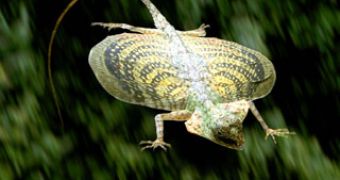
 14 DAY TRIAL //
14 DAY TRIAL // 
